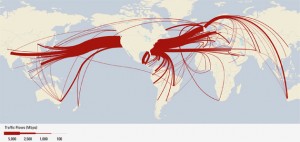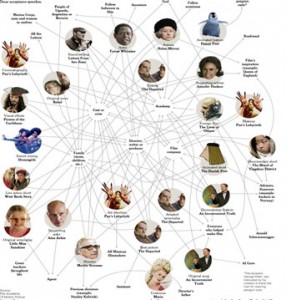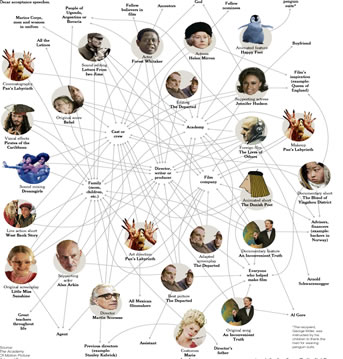We live in a world of instant communication, that speeds data, voice and images around the planet at the speed of light. It is a world both wired and wireless.

This is a world far removed from when James Martin wrote “The Wired Society” in the 1970s. In Martin’s world computers filled half a room, down-sized from from even bigger systems that spawned our modern computer age. For Martin his wired society meant computers with smart programs that could be accessed by terminal for human interaction. Martin’s world didn’t include networks of personal computers, server farms, super computers and non-computer devices all wired together, all able to talk to each other in a seamless world. His world didn’t include the Internet.
The Internet is the disruptive technology that has set off a revolution in communications. Having come a long way from its roots in the early 1980s when only a handful of researchers at two universities could interconnect, the Internet of today reveals some amazing statistics:
Current Users = 2.7 billion
Percentage of the world’s population with Internet access = 33%
Number of websites worldwide = 530 million
Number of blogs (like this one) worldwide = 181 million
If you have an email account then you are one in 3.4 billion.
Other interesting email statistics:
Number of wireless email users 2011 = 531 million
Estimated number of wireless email users by 2015 = 1.2 billion
Number of emails average Internet users send or receive each day = 110
Number of spam emails received per user per day = 13 (approximately 17% of daily emails)
Annual spam email contribution to greenhouse gases = 20 million tons
Initially the Internet connected university computer networks together but with the development of the Worldwide Web and web browsers this technology moved from the realm of academics to the public domain. Today the Internet connects much more than computers and includes devices like phones, smart meters, refrigerators, televisions, thermostats, watches, music players, automobiles and more. In fact, any technology using a computer chip that includes wireless or wired communication can be an Internet device.
Mobile Internet connections represent the fastest growing segment with billions of devices talking to each other. And in the near future those numbers will increase geometrically. Forecasters predict:
+10 billion devices by 2016 (almost 3 billion more than the human population of the planet)
24 billion devices by 2020
Here are some examples of what these devices are and will be doing:
- Environmental monitoring of soil, water and air in forests and farms
- Sensors embedded in the exterior and interior of buildings to optimize energy and lighting
- Remote monitoring of power generation systems from photovoltaics to wind farms to detect outages and balance energy flow to the power grid
- Monitoring machine operations check in on vibration, power usage and other key indicators to optimize predictive maintenance and ensure up time
- Mobile applications for personal communications devices that can serve to monitor and report on smog levels or ground-level ozone, traffic conditions, and other in situation events in real time
- Measuring, monitoring and regulating temperature in cold storage appliances in a wide variety of industries
- Vehicle-to-vehicle connectivity to optimize traffic flow on congested routes
- Vehicle-to-facility connectivity to point out where parking spaces can be located
- Remote monitoring of patients in their own homes to alert health professionals to a life threatening situation
In every way the Internet has had a disruptive impact. Some would argue it has all been positive. But for many the disruption has been negative. Just ask people in publishing, music, film, television, and the arts and they will have stories to tell about how the Internet has created enormous headaches for their business.
The Internet has provided a conduit for unparalleled social interaction. It has changed the way we learn, the way we do research, the way we write. Here’s another interesting statistic:
Number of Internet searches conducted each minute = 4 million
Most of those searches are done on Google, a search engine website that I use every day when developing the content for articles like the one you are reading now.
Even compiled knowledge sources have changed with Encyclopedia Britannica ending its print editions to become an online service in the hope that it can stave off the impact of a publicly assembled set of knowledge to be found in Wikipedia.
The Rise of the Social Internet

The phenomena of social networks such as Facebook and LinkedIn represent a dramatic change in the way humans interact on this planet. Today social and the Internet are one whether you are “friending” someone on Facebook, “linking” to someone on LinkedIn or selecting a date or life mate on eHarmony or Match.com.
Just how powerful is “social” on the Internet today? Match.com states that in one in five young people are getting hooked up on dates through Internet sites. Getting hitched has gone electronic. And what is the volume of “social” on the Internet today? Here is a snapshot of the month of March 2012 for Facebook, the largest social network on the planet, the third biggest human organization, only smaller than China and India. The statistics are staggering:
901 million members (expected to hit one billion by year end)
740 billion minutes on the site throughout the month
Daily uploads and sharing of 300 million photographs
Postings liked or commented on amounting to 3.2 billion daily
More than half the members during the month connected using mobile devices.
More than 80% of members were not from North America
Communication on the site was in 70 different languages
For the world of business LinkedIn represented a professional alternative to the “social” aspects of Facebook. And its numbers although a fraction in comparison represent the power of Internet connectivity for business-to-business relationship building. Here are a few LinkedIn facts for the month of March 2012:
New members joined at a rate of 2 per second
Total membership exceeded 161 million representing 200 nations or territories
More than 2 million companies had LinkedIn pages
For the world the implications of Internet connectivity through wireless devices combined with social networks represents a paradigm shift in the balance of power. For governments the challenge has become one of responsiveness. Can nations move as fast as people in the event of an issue or cause that attracts a response within the online social community? Will the online interconnectedness break down national barriers and lead to a reorganized world? Will web-based technology change the way we interact with the natural world? Will citizen scientists police and report on corporate violators of the environment shaming them to act more responsibly? Will citizens ignore their national governments in the name of a cause? Will “Arab Springs” turn into “North American springs” like the “Occupy Wall Street” movement and will this become the means by which change happens.
In Part 2 of this topic we will look at where we are headed on the Internet and the worldwide web and just how altered our world will be by 2100.









